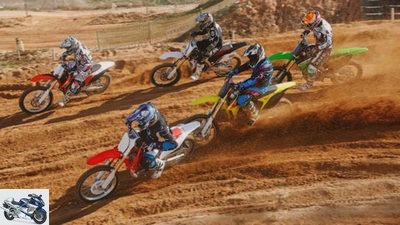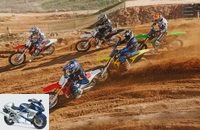Menus
- The revised 250 cc Crosser in comparison
- Kawasaki KX 250 F
- Honda CRF 250 R.
- KTM 250 SX-F
- Suzuki RM- Z 250
- Conclusion
- Honda CRF 250 R.
- Kawasaki KX 250 F
- KTM 250 SX-F
- Suzuki RM-Z 250
- Yamaha YZ 250 F.
- Recent changes

Motociclismo
Comparison test: 250 cc motocross 2011
The revised 250 cc Crosser in comparison
If you don’t want to be sandblasted by your colleagues in motocross, you need two things: a good chassis and a powerful engine. Especially in the MX2 class (up to 250 cm³). Because the smaller the displacement, the more important every detail becomes.
Motorland Aragón. Just last September, Valentino Rossi and Co. put the brand new race track in the focus of public interest at the Grand Prix. What was hidden from the TV cameras: With supermoto, dirt track, enduro and motocross slopes, the Spanish facility also offers off-road fans an extensive playground – and thus perfect conditions to check out the MX2 bikes for the 2011 season to feel. While Honda, Suzuki and Yamaha only revised their 250cc crossers and adjusted them to the stricter noise limits that came into force in 2011, they blow Kawasaki and above all KTM for the upcoming season to attack (see also "Recent changes"). Who is missing? After the Italian off-road forge TM Racing traditionally does not take part in MOTORRAD comparative tests, Husqvarna also apologized for the 2011 summit.
Buy complete article

Comparison test: 250 cc motocross 2011
The revised 250 cc Crosser in comparison
Yamaha YZ 250 F.
Motociclismo
The Yamaha YZ 250 F.
So nothing new with the quarter-liter Yamaha. This is only surprising at second glance. After all, the Yamaha technicians turned the YZ 250 F completely upside down only a year ago. With bridge frames instead of single-loop frames and completely new plastic parts, the engineers fundamentally modernized the 250cc Crosser. The robust five-valve engine remained largely unchanged, and is now the only engine in this class that is still fed by a carburetor. And this propellant has to stretch properly even in the pepped up environment.
While the potent pressure in the lower revs makes it easy for the driver to accelerate out of tight corners, the Yamaha engine remains restrained in the upper rev range. Upshifting early is a basic principle for speedy progress. There is also power in calm on the chassis side. Because the front-wheel-oriented steering behavior typical of the Yamaha crossers also preserves the new chassis. Highly precise turning, unexcited straight-line stability and excellently coordinated spring elements cooperate for a homogeneous overall concept. Ultimately, the only thing missing is a lively drive unit to fully develop.
Kawasaki KX 250 F
Motociclismo
The Kawasaki KX 250 F.
Two years after the 450 sister model, the KX 250 F is now also being launched with petrol injection. Which doesn’t change the character of the Kawa single. Whether the full pressure from the adjacent building or the powerful spurt on short straights, the KX unit pushes ahead impressively. Only in the uppermost speed range does the thrust flatten out a little, making it sensible to shift up in the middle speed range. In addition, the propellant shines with a noticeably low internal friction, making the machine in the air or when braking almost as reactive as a two-stroke.
A pleasure, provided you can make friends with the peculiarities of the chassis. The more expansive dimensions of the KX compared to the rest of the test field are still a matter of taste, and larger pilots are even accommodated by the more spacious space available, which irritates the tuning of the strut. Although a little less pronounced than in the comparison test of the 2010 models (MOTORRAD 3/2010), the monoshock of the current 250 series also works its way relatively far into the suspension travel while driving, holding the rear in spite of the correctly adjusted spring base (sag without driver: 25, with driver : 95 millimeters) unusually deep. The result: In tight bends, the front pushes towards the outside of the bend. This phenomenon could not be dealt with with the fork legs pushed through to the maximum in the fork bridge. Speaking of fork legs: With the Separate Function Fork (SFF) from Showa, Kawasaki is venturing into previously unknown territory. The fork spatially separates the suspension and damping from one another with a spring in the left fork leg and the damping cartridge in the right leg. The reasons: not so much the weight saving of around 300 grams, but above all the additional space gained in the right bar, which is helpful for precise damping work.
The front also impresses with its extraordinarily wide range of settings, only lags a tad behind its colleagues in terms of responsiveness. This and above all the idiosyncratic steering behavior are enough to let the basically potent Kawa land in the tightly closed field – together with the Yamaha – just behind the leading trio.
Honda CRF 250 R.
Motociclismo
The Honda CRF 250 R.
To a certain extent, the conceptual counterpart to the Kawasaki is the Honda. Because "Easy riding" best describes the driving experience on the CRF. Regardless of whether it is the comfortable, extremely sensitive suspension, which is nevertheless equipped with sufficient punch reserves, the ergonomics that are almost perfect for all driver sizes, or the razor-sharp handling – when it comes to the chassis, the little red car flatters itself with an astonishing balance. This creates a relationship of trust that even allows the power output typical of Honda crossers to be overlooked. Because despite the power output measured on the test bench, the Honda ensures a good mood in practice in the lower and middle speeds, but is cautious when it comes to revving. Which – again typically Honda – changes little in the user-friendliness of the ohc unit and gives the CRF 250 R third place overall.
KTM 250 SX-F
Motociclismo
The KTM 250 SX-F.
With a lot of praise, the KTM rolls behind the gate. Not only because the Austrians were able to win the MX2 World Championship for the third time in a row with the 250 SX-F, but also made by far the greatest development effort for the series offshoot of the factory machine for the 2011 season. Above all, the spring strut activated via a reversing lever represents a courageous step in the belief that the KTM executives have been applying for years to the directly linked PDS system. One that has paid off. With a sensitive response, the new technology for KTM makes you forget the PDS monoshock, which is especially rough in smaller acceleration waves. In terms of comfort and traction, the rear of the new SX-F is well above all its predecessors. Especially since the reduced kicking of the rear noticeably relieves the load on the front fork, which was not always problem-free in the past, and now allows the front to act more smoothly. However, heavier pilots should use a stiffer spring so as not to increase the tendency of the front section to understeer due to a tail that is too low.
Nevertheless: If the progress on the chassis would have been enough for a top placement, the engine does the rest. Despite the power loss of two hp compared to the 2010 model, which is most likely due to the silencer, the injection engine is clearly superior to the competition, especially in the medium speed range, without having to pay tribute to this characteristic on higher tours. No light without shadow: The noticeable mechanical friction and rough engine running make the Alpen-Single the toughest fellow among the quarter-liter drives.
Suzuki RM- Z 250
Motociclismo
The Suzuki RM- Z 250.
A year ago, the Suzuki celebrated its first victory in a MOTORRAD comparison test of the MX2 crossers. The yellow one owed this little sensation to its distinctly harmonious overall concept, with which it knows how to impress in the new season despite – or thanks to – only moderate model updates. Whether the spring elements, which represent an extremely successful compromise with excellent response behavior and sufficient puncture resistance, a precisely controllable, handy and yet sufficiently stable chassis or the successful ergonomics that are suitable for a wide range of drivers: the RM-Z shines on the chassis side as a highly talented all-rounder. Which also applies to the engine. Although the Suzuki single had to be cut back to 35 HP peak power (2010: 38 HP) due to the noise restriction that came into force in 2011, the unit is still enthusiastic. Whether the spontaneous acceleration from the lower speed range, the wide usable medium speed range or the impressive revving: Hardly any engine draws the bow as skilfully as the Suzuki propellant, making hobby and professional crossers equally happy. And ultimately ensures that the Suzuki also takes overall victory in the 2011 cross comparison.
Conclusion
Motociclismo
The Suzuki RM-Z 250 can fight its way to the top thanks to the successful chassis.
1st place: Suzuki RM-Z 250
Top engine in a successful chassis – a recipe for success can sound so uncomplicated. The RM-Z won the test with impressive homogeneity.
2nd place: KTM 250 SX-F
So far, the KTM has mainly impressed with its powerful engine. Now the new rear suspension and better ergonomics are also advancing the chassis. A good combination.
3rd place: Honda CRF 250 R
Smooth engine, comfortable chassis – the Honda ensures easy riding in motocross. And professionals are also happy about their playful handling and excellent steering precision.
4th place: Kawasaki KX 250 F
The lively, mechanically easy-running engine is the highlight of the Kawasaki. The front, which tends to understeer, and the lush dimensions, however, require getting used to.
4th place: Yamaha YZ 250 F
The Yamaha can’t do anything worse, but it can’t do anything better than its competition. But the solid average is no longer enough for a top result in the narrowly spread MX2 field.
MOTORCYCLE scoring
| Max points | Honda | Kawasaki | KTM | Suzuki | Yamaha | engine | 120 | 103 | 105 | 105 | 107 | 100 |
| landing gear | 100 | 88 | 84 | 89 | 89 | 89 | miscellaneous | 30th | 26th | 26th | 25th | 24 | 26th |
| total | 250 | 217 | 215 | 219 | 220 | 215 |
| placement | 3. | 4th. | 2. | 1. | 4th. |

Enduro
Comparison test: travel enduro bikes in Sweden
Test: travel enduros on the way to the North Cape (part 2)
read more
Honda CRF 250 R.
Motociclismo
Pole of calm: Not only the steering damper (left) ensures calm. No crosser needs less getting used to than the CRF.
| engine | design type | Water-cooled, single-cylinder ohc four-stroke engine with four valves per cylinder |
| Bore x stroke | 76.8 x 53.8 mm | Displacement | 249 cc |
| compression | 13.2 | Performance1 | 26.7 kW (36 hp) |
| at speed | 12250 rpm | injection | Ø 50 mm |
| Corridors | 5 | landing gear | frame | Bridge frame made of aluminum |
| fork | Showa | Sliding tube | Ø 48 mm |
| Strut | Showa | Weight | 100 kg |
| Price excluding additional costs | |
| 7330 euros |
Kawasaki KX 250 F
Motociclismo
The SFF fork with separate suspension and damping is unique, but the strength of the Kawa lies in its engine, which is now equipped with injection.
| engine | design type | Water-cooled single cylinder dohc four-stroke engine with four valves per cylinder. |
| Bore x stroke | 77 x 53.6 mm | Displacement | 249 cc |
| compression | 13.5 | Performance1 | 26.7 kW (36 PS) |
| at speed | 13250 rpm | injection | Ø 43 mm |
| Corridors | 5 | landing gear | frame | Bridge frame made of aluminum |
| fork | Showa | Sliding tube | Ø 47 mm |
| Strut | Showa | Weight | 100 kg |
| Price excluding additional costs | |
| 7330 euros |
KTM 250 SX-F
Motociclismo
Much sweat, much honor? Petrol injection and reversing lever are just the most noticeable changes – the KTM has been completely redesigned.
| engine | design type | Water-cooled single cylinder dohc four-stroke engine with four valves per cylinder. |
| Bore x stroke | 76 x 54.8 mm | Displacement | 248 cc |
| compression | 13.2 | Performance1 | 26.5 kW (36 hp) |
| at speed | 10750 rpm | injection | Ø 42 mm |
| Corridors | 6th | landing gear | frame | Single-loop frame made of tubular steel |
| fork | WP suspension | Sliding tube | Ø 48 mm |
| Strut | WP suspension | Weight | 100 kg |
| Price excluding additional costs | |
| 7,995 euros |
Suzuki RM-Z 250
Motociclismo
The RM-Z impresses with its homogeneity. Lower noise limits force all manufacturers to use quieter silencers.
| engine | design type | Water-cooled single cylinder dohc four-stroke engine with four valves per cylinder. |
| Bore x stroke | 77 x 53.6 mm | Displacement | 249 cc |
| compression | 13.5 | Performance1 | 26.1 kW (35 PS) |
| at speed | 11000 rpm | injection | Ø 43 mm |
| Corridors | 5 | landing gear | frame | Bridge frame made of aluminum |
| fork | Showa | Sliding tube | Ø 47 mm |
| Strut | Showa | Weight | 101 kg |
| Price excluding additional costs | |
| 7530 euros |
Yamaha YZ 250 F.
Motociclismo
The last of its kind: carburettor instead of gasoline injection in the Yamaha single. In return, the concept of the aluminum frame and the lines are pleasingly independent.
| engine | design type | Water-cooled single cylinder dohc four-stroke engine with five valves per cylinder. |
| Bore x stroke | 77 x 53.6 mm | Displacement | 249 cc |
| compression | 13.5 | Performance1 | 26.4 kW (36 PS) |
| at speed | 11750 rpm | injection | Carburettor / Ø 37 mm |
| Corridors | 5 | landing gear | frame | Bridge frame made of aluminum |
| fork | Kayaba | Sliding tube | Ø 48 mm |
| Strut | Kayaba | Weight | 98 kg |
| Price excluding additional costs | |
| 7,995 euros |
Recent changes
- Honda CRF 250 R.: Steering damper with larger piston diameter (24 instead of 20 mm), silencer quieter.
- Kawasaki KX 250 F: Petrol injection (2010: carburettor), SFF fork (spring in the right handlebar, damping cartridge in the left handlebar), camshafts changed, compression increased to 13.5 (2010: 13.2), swing arm lengthened (identical to the swing arm of the KX 450 F), silencer quieter.
- KTM 250 SX-F: New engine housing (identical to 350 SX-F), petrol injection (2010: carburetor), compression increased to 13.2 (2010: 12.8), new frame, rocker arm for the strut (2010: PDS), redesigned plastic parts, Silencer quieter.
- Suzuki RM-Z 250: Camshafts changed, transmission (3rd and 4th gear) reinforced, silencer quieter.
- Yamaha YZ 250 F: No changes
Related articles
-
Comparison test: 17 hp motorcycles
Comparison test, Honda CB Two Fifty, Honda CMX 250 Rebel, Kawasaki Estrella 250, Yamaha XV 250 17 hp motorcycles Because of the sports boom and chopper…
-
Comparison test of 450 cc motocrosss
Motociclismo comparative test 450 cc Motocross 2011 Crosser from Honda, Kawasaki, KTM, Suzuki and Yamaha, of all things, in the Motocross premier class (MX1, …
-
Comparison test 250 cc four-stroke motocrosser
Jahn Comparison test 250 cc four-stroke motocrosser Welcome to the club Two measures are two too few? now also in motocross. It is understandable that in…
-
Comparison test of 125 cc motocross bikes
Comparison test of 125 cc motocross bikes Air guns Which eight-liter crosser bounces, drives and flies best? At the control stick for MOTORCYCLE – the…
-
Motocross comparison test MX1 450 cc
Jahn 44 pictures Jahn 1/44 The Honda CRF 450 R, Kawasaki KX 450 F, KTM 350 SX-F, KTM 450 SX-F, Suzuki RM-Z 450 and Yamaha YZ 450 F. Jahn …
-
Comparison test Suzuki SV 650, Honda CB 650 F, Kawasaki ER-6n, Yamaha MT-07
www.bilski-fotografie.de 34 pictures www.bilski-fotografie.de 1/34 They are the hottest candidates among the middle class naked bikes ….
-
Comparison test MX2 motocrosser
Gargolov 46 pictures Gargolov 1/46 The KTM takes victory, the second placed Husqvarna is meanwhile moved a bit more appropriately. The…
-
Comparison test of naked bikes from Japan
Art 15 pictures Art 1/15 Art 2/15 Art 3/15 Art 4/15 Art 5/15 Art 6/15 Art 7/15 Art 8/15 Art 9/15 Art 10/15 …
-
Jahn 35 pictures Jahn 1/35 Husqvarna TC 250 R in the motocross comparison test. Jahn 2/35 Yamaha YZ 250 F in the motocross comparison test. Jahn 3/35 Husqvarna TC …
-
Motocross Comparison Test – Honda, Kawasaki, KTM, Suzuki and Yamaha
Jahn 16 pictures Jahn 1/16 Kawasaki KX 450 F, KTM 350 SX-F, Yamaha YZ 450 F, KTM 450 SX-F, Suzuki RM-Z 450 and Honda CRF 450 R in the large MX1 (450cm³) …